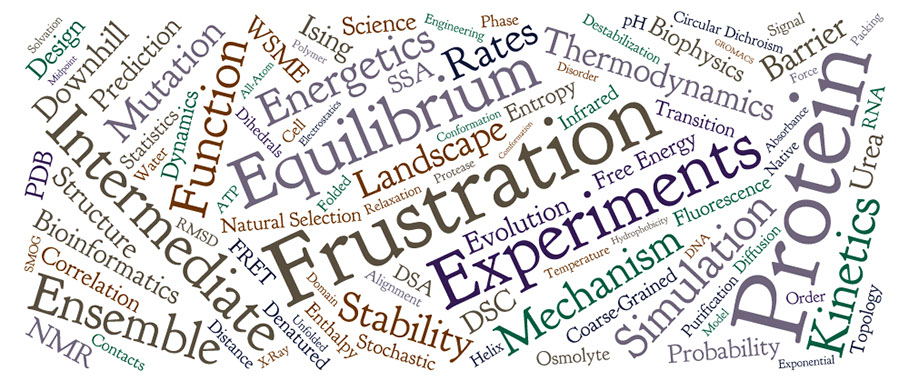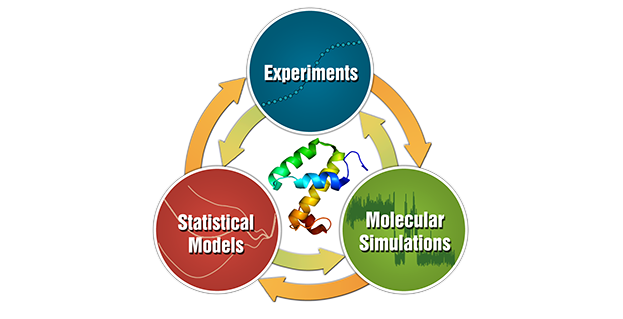 Protein Biophysics Lab
Protein Biophysics Lab 
A) Experimental Characterization of Protein Conformational Behavior and its Relation to Function.
Our primary aim is to understand the mapping of protein sequence onto the structure and hence onto the function. Since protein function is the overriding force that drives the evolution of protein sequences, we are currently studying a collection of homologous transcription factors (both ordered and disordered) to identify the extent to which function and its structural requirements influence the folding mechanistic features of proteins. Particularly, we are interested in the characterizing the subtle energetic-entropic factors determining the folding rates and stability of proteins, energetic frustration and their role in populating folding intermediates and functional studies on mutants that alleviate or promote frustration. Our experimental approach involves a thorough spectroscopic analysis of folding thermodynamics using multiple probes (CD, fluorescence, DSC etc.), kinetic studies to determine the rate of folding/unfolding (mainly fluorescence), and binding strength and promiscuity estimation by ITC. Experimental studies are supplemented with both theoretical calculations and simulations (coarse-grained or atomistic) to unite protein folding and functional determinants within a single coherent framework.
Further Reading:
1. Conformational dynamics and ensembles in protein folding. ![]()
2. Downhill protein folding: evolution meets physics. ![]()
3. Navigating the downhill protein folding regime via structural homologues. ![]()
4. Thermodynamics of downhill folding: multi-probe analysis of PDD, a protein that folds over a marginal free energy barrier. ![]()
5. Frustration in biomolecules. ![]()
B) Modeling and Predicting Folding Landscapes using Statistical Models.
Protein folding studies, however complex, are typically interpreted with simple two-state or three-state chemical models. On the other hand, theoretical treatments of folding point to the fact that the polymeric chain can sample multitudes of conformations (microstates) and that the folded-functional structure is just one among of many that could be populated. It is of course possible that this complexity has been simplified through Natural Selection, thus eventually resulting a simple two-state or three-state like folding. But trying to understand folding mechanisms from these chemical models would trivialize the problem and hide the mapping of sequence patterning on the folding features.
To discern the origins of folding complexity or the lack of it, we have added multiple energetic terms – vdW interactions, electrostatics, solvation, and residue specific conformational entropy - into a simple structure-based statistical mechanical model (the Wako-Saitô-Muñoz-Eaton model) (Wako H & Saitô N, 1978; Muñoz V & Eaton WA, 1999). Since the model relies on the native structure of the protein and is sufficiently detailed, it is highly predictive by definition. Moreover, the folding thermodynamics and kinetics can be rapidly obtained at a residue-level resolution. The various versions of the model - exact-solution, SSA, DSA, TSA, DSA with interactions between two structured regions – are currently employed by us to not just characterize the folding mechanism but also to calibrate the magnitude of the model’s energetic terms. We have already identified several novel features in protein folding (some of which have been hinted at by experiments) using this model including the role of residual frustration in the ‘folding’ of disordered proteins (Naganathan AN & Orozco M, 2013), sequential folding mechanism (Narayan A & Naganathan AN, 2014) and a domino-like destabilization mechanism (Sivanandan S & Naganathan AN, 2013), to name a few. We have also shown that the model is powerful enough to engineer protein stabilities by tuning the magnitude of charge-charge interactions.
We are currently building a web-server that takes solely the protein structure as input and predicts multiple folding related features using this model (in a few hours time). Experimentalists could employ the output to better understand the folding mechanism or fine-tune their experiments or to identify novel avenues in their approaches.
Further Reading:
1. Statistical Mechanical Theory of the Protein Conformation. II. Folding Pathway for Protein. ![]()
2. Funnels, pathways, and the energy landscape of protein folding: a synthesis. ![]()
3. A simple model for calculating the kinetics of protein folding from three-dimensional structures. ![]()
4. Exact solution of the Muñoz-Eaton model for protein folding. ![]()
5. Quantitative prediction of protein folding behaviors from a simple statistical model. ![]()
C) Understanding Protein Folding and Dynamics through Simulations.
We perform both conventional and replica-exchange molecular dynamics (MD) simulations of proteins (thanks to GROMACS). Because they are time-consuming, we are currently employing them as tools to validate the predictions of statistical models in cases where experiments are not immediately possible and to also look for any consistency with experimental results. We perform coarse-grained (CG) simulations (thanks to the SMOG web-server) to improve sampling and to obtain seed-points for atomistic MD. We have recently shown that CG simulations are powerful enough, if carefully calibrated against experimental observables, to identify partially structured states that are functionally relevant, i.e. evidence for the mechanism of conformational selection in binding (Naganathan AN & Orozco M, 2011).
Further Reading:
1. Biomolecular simulation: a computational microscope for molecular biology. ![]()
2. To milliseconds and beyond: challenges in the simulation of protein folding. ![]()
3. An all-atom structure-based potential for proteins: bridging minimal models with all-atom empirical forcefields. ![]()
4. The native ensemble and folding of a protein molten-globule: functional consequence of downhill folding. ![]()

Back to Top>>

2023, Maintained by Protein Biophysics Lab, IIT Madras, Chennai-36, India